Församlingens Vän
Sometimes our wishes are fulfilled, but in ways we didn't expect. One such wish was prompted by a visit to the Wahoo museum where a volunteer there told us we needed to pay a visit to Doug Swanson, the car dealer in Ceresco, because he had a collection of Swedish books. That was too good a tip to pass up, so on a carpet shopping trip to another Swanson, Ernie, I sneaked across the street to check on Doug. That was a great move, for we got to see as much of the collection as time would allow and copied a church newsletter which was featured in an earlier column. The rest of the shopping contingent was less than happy with this defection across the street.
Then unhappiness was compounded some years later when it was learned that we missed Doug's auction sale when he retired. How could that have happened? He even sold the Swedish books. The surprising twist to the story was that at least one box of Swedish books was bought by someone from Stromsburg, and by the mysterious and wonderful working of fate, ended up in the Folkets Vän basement with all the others! To be sure this is just a stop along their road to the Immigrant Archive that is the greatest wish of ours, ever growing in urgency.
In this box were four children's books, a hymnal and Christmas annual, a book of sermons by Rev. Karl Forsman, and a book called "Bible Treasury" by professor P.A. Ahlberg featuring daily readings and commentary. He was the teacher of many of our immigrant pastors in what was called the "Ahlberg School." But the best of the best were two books never before seen: one a small pamphlet by Nils Frykman telling the stories of how he came to write some of the most favorite of the Swedish hymns. It was finished and published by his son, A.T. Frykman, who was pastor of the Wausa Mission church. The other is a book of humorous and entertaining verse called "Rimfrost." The theme of its author, Rev. S.G. Sjöquist, is to scatter frost flakes (rimfrost) on the fevered and troubled world around him to cool and soothe. I hope to tell more about each of these in weeks to come.
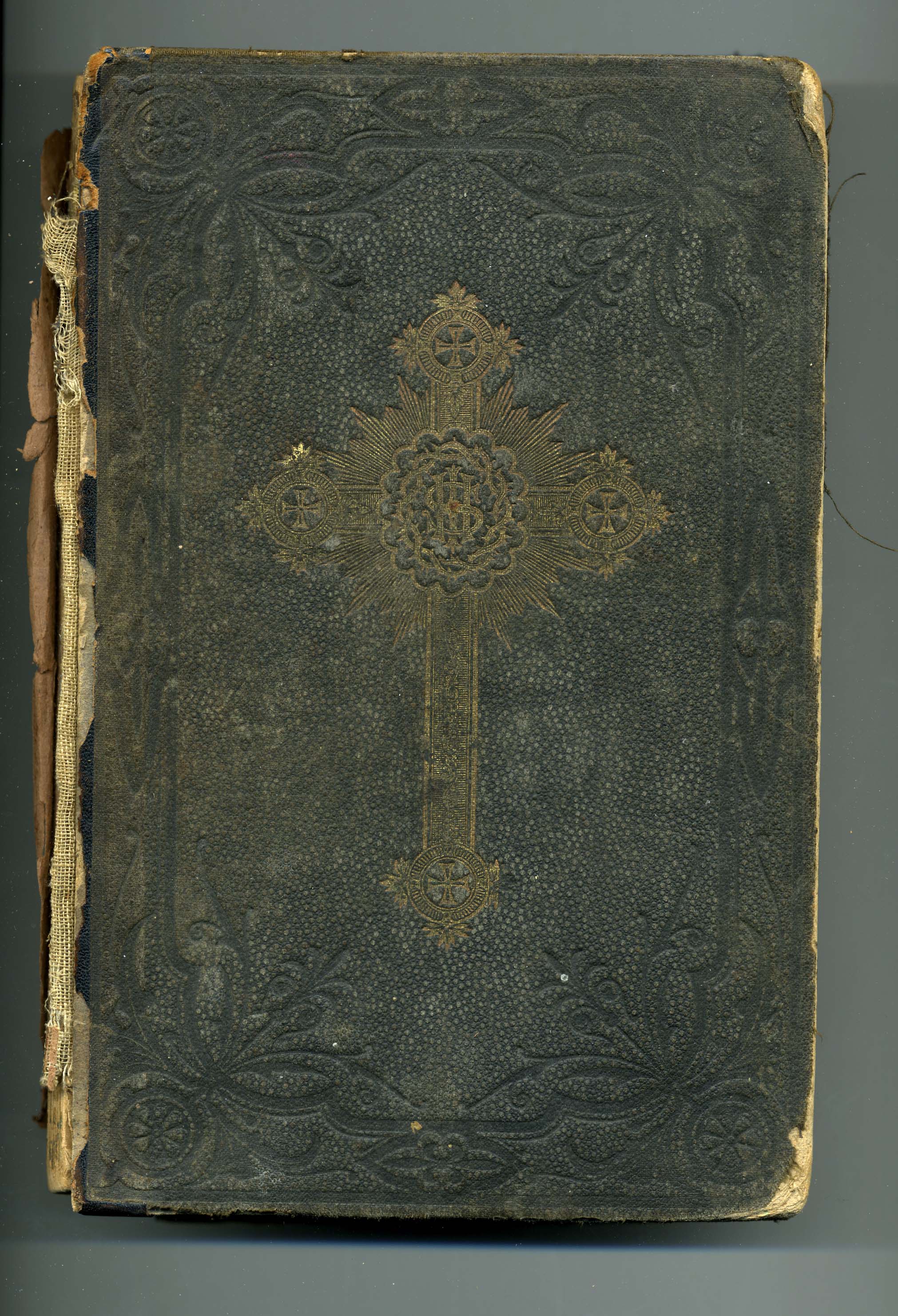
P.A.Ahlberg daily Bible readings - 1893
-Dalakarl
......................................................................
More from the Doug Swanson collection

S.G. Sjöquist
He writes of a recent annual meeting of the Covenant, one of the first, and some heated issues that surfaced. Critics of North Park and its head, David Nyvall, are mentioned. "För han i disciplinen var för slapp" means he was too lax in discipline; the claim of MissionsWännen editors. Of president Björk he writes "Han är en björk, som kan ge gossar ris;" that is, sitting calmly by he restored order to the meeting by rapping his gavel on the table. "He is a birch" (a switch) that can "keep the boys in line." Birch is the literal translation of björk.
Also in the air at the time were some speculations by E.P. Ekman, president of the Covenant of Sweden, that in the final consummation of history all people would be saved. This came to be held by the Universalist church in America, one of the later partnership- Unitarian-Universalists. The second major Mission Friend paper, Chicago-Bladet weighed in firmly against this: Sjöquist writes "Chicago-Bladet lärer: upp vi brinna-" "Och efter döden frälsning är at finna, Det stor i Ekmans nya theologi." That is; they teach that we burn up, not apt to be saved after death "as it stands in Ekman's new theology."
It appears that Sjöquist supplied his verses to the MissionWannen newspaper who must have published them. They surely would have been a welcomed counterpoint to the heated debates then raging. The cooling frost scattered upon this landscape was an apt metaphor for his light-hearted "take" on the issues of the time. "Rimfrost" is a delight to read.
-Dalakarl
..............................................................
Another Swedish Name
While looking at these pictures recently I took note of family names that have disappeared from our fellowship. One such name was "Hellstrom." There were quite a few Hellstroms at one time, but the only one I remember was Walford (or was it Walferd?) who may have been a resident at Covenant Home. But the name "Hellstrom" made me wonder what Swedish word supplied the first part. The second part is easy: "stream."
Consulting the dictionary, first the word "häl" was checked. It means "heel." Not likely. Then the word "hell,"...it means "hail" as in "hail to the chief." In case you are wondering, the Swedish word for the place of eternal punishment is "helvete," which we can be sure had nothing to do with the Hellstroms' name. "Hel" with one "l" means "whole." Whole stream doesn't sound like a name either.
Finally we found "hal," which can mean "smooth" as well as "slippery" or "oily." "Smooth stream" seems like the best candidate for the original meaning of this ornamental name. Often the English version of Swedish names were suggested by non-Swedish-speaking helpers and adopted by non-English-speaking immigrants. That may account for the name of our friends, the Hellstroms.
Another thing about Swedish names: many locations on Swedish maps feature a name ending in "näs" (nose). These are all on shorelines, and that leads me to believe that näs is the Swedish version of "point" in English. So "Siljansnäs," a prominent projection into Lake Siljan, would be "Siljan's Point" in English.
-Dalakarl
.................................................................
Dr. L. Harold DeWolf
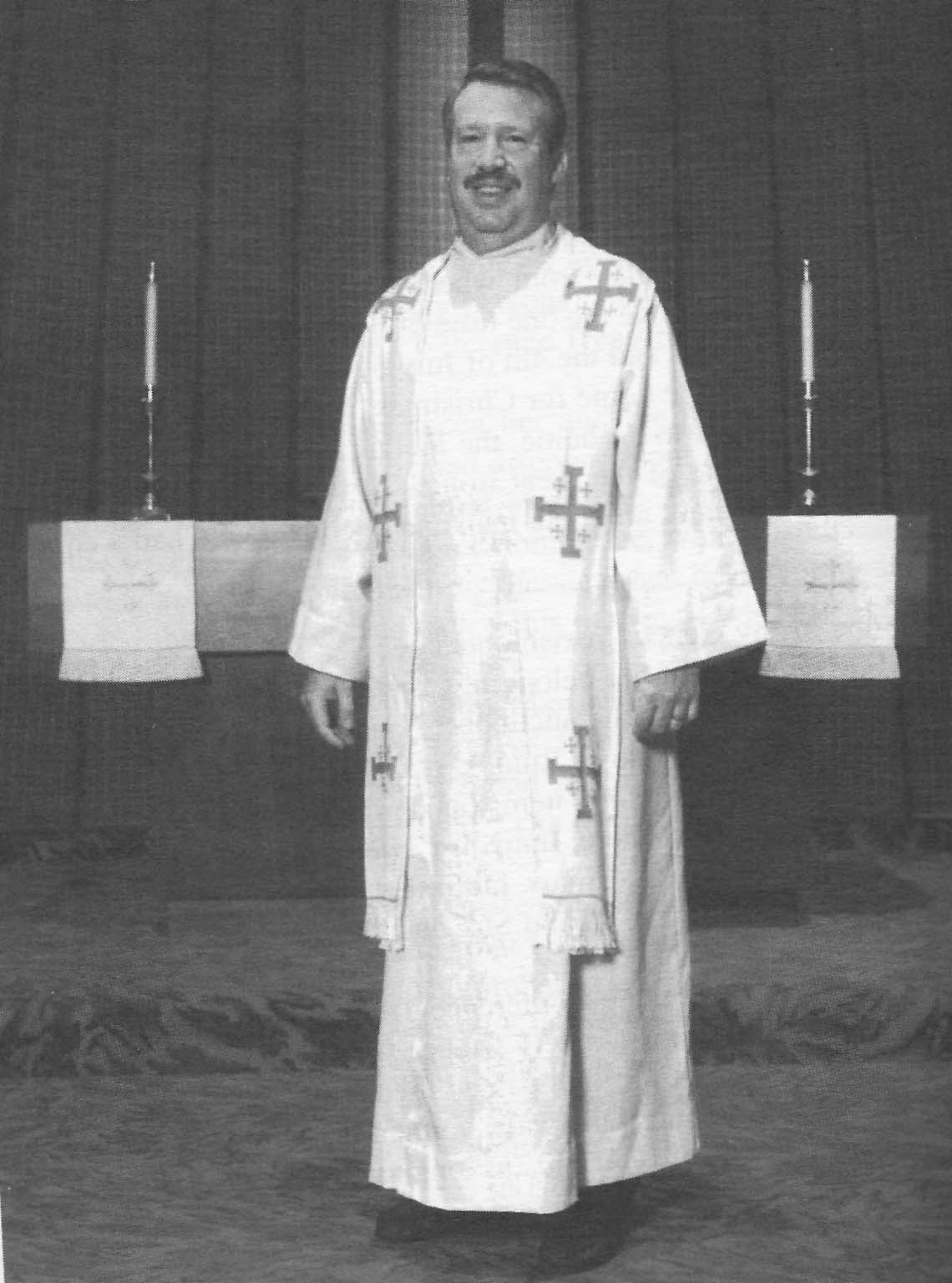
"Saint Charles" Leypoldt
Among many other things learned from this book, one of the most striking was that a well-known theologian associated with the Southern Christian Leadership Conference and Dr. Martin Luther King Jr. was from York! Chuck tells of finding one of his books in a store in York at a bargain price. Here is what we have found to support this claim:
"Relationship with Martin Luther King, Jr. Dr. Lotan Harold DeWolf taught theology at Boston University from 1934 to 1965, where he was the dissertation advisor for a young Martin Luther King, Jr. After Dr. King's graduation, Harold continued to correspond with him and accompanied him on the 1965 Selma, Alabama protest marches.
Dr. King wrote to Dr. DeWolf: “Both your stimulating lectures and your profound ideas will remain with me so long as the cords of memory shall lengthen. I have discovered that both theologically and philosophically much of my thinking is DeWolfian” (Letter from King to DeWolf, 2 June 1955).

Dr. DeWolf,left
Funeral Tribute to Martin Luther King Jr. Ebenezer Baptist Church, Atlanta April 9, 1968 By L. Harold DeWolf : It was my privilege to teach Martin Luther King, to march with him in Mississippi, agonize and pray with him in the midst of the worst violence at St. Augustine, to spend many hours counseling with him, to go through great volumes of his private papers organizing them, to spend many days and nights in his home. I know the innermost thoughts of this man as deeply as I know that of any man on earth. It has been the highest privilege of my life, this personal friendship. "
Retrieving little known facts from the dustbins of history is at the heart of our charter.
-Dalakarl
...........................................................
Nils Frykman
This familiarity made the little book interesting, but even more so because A.T. Frykman had been the pastor of my home church at one time, and my great-grandfather was a fan of his. He wrote: "He was a good student of the scriptures, so that the listener took the text home with him. The young people considered him their friend; he was effective in supervision, and could stimulate one's thinking."
Then, to top it off, his daughter married into the family of my best friend and we correspond with his granddaughter from time to time. These titles stand out in memory: "Our Mighty God Works Mighty Wonders," the Christmas song "Joy Bells are Ringing," "Why Should I be Anxious?, "I Have a Friend Who Loveth Me," and "I Have a Future All Sublime." Apparently this last one was done in cooperation with Minnesota hymnist A.L. Skoog, because that title is inscribed on his tombstone. There was a special memorial service for Skoog at the Stromsburg Mission church at his passing...his daughter was married to a Myrberg here.
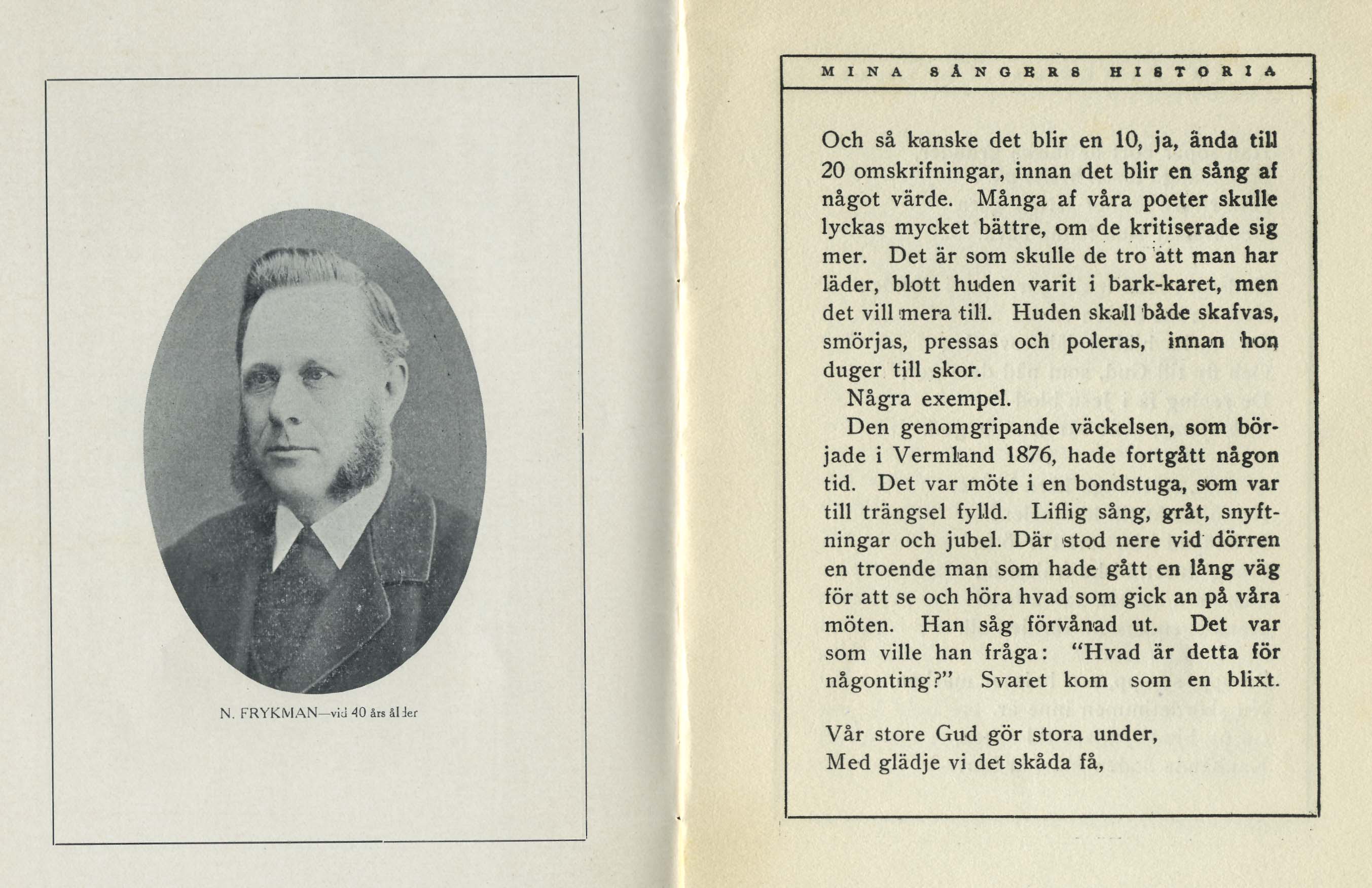
"Our Mighty God Works Mighty Wonders
What Joy To See Them All Around"
The book was published in 1912 and cost 35 cents. It had a used book price of 10 cents on the cover. Some of my friends at Covenant Home still remember these songs, but I have trouble singing them publicly. I tend to "get something in my eye."
-Dalakarl
.......................................................................
Kawneer Co. Founder
"In York we have a pair of Swedish brothers, A.G. and Vic, known for counties around and for many years as the Johnson Bros. Twenty-eight years ago, or to be exact, in 1907, they loaned their exquisite Indian beadwork collection valued at $2,000 at that time, perhaps priceless today, to the Historical Society at Lincoln.
During all of these many years the state legislature failed to make any appropriation for the purchase of this valuable collection, so Johnson Bros. up the other day and sold it to a dear millionaire friend, Mr. F.J. Plym, a manufacturer of Niles Mich. Anyone who can accumulate his million is news and we should focalize on this man's life a moment. He and Oscar Rystrom played and worked together as boys in Polk county. Then later in Chadron where the Johnsons met him he was known as the boy carpenter, a pick-up trade. In the spring of 1891, with a couple of other young men and an older ranchman, they drove a team and wagon to Pierre, South Dakota. In making this journey they were forced to cross Pine Ridge Reservation on the day preceding the battle of Wounded Knee. That night they slept soundly in a teepee very near what was destined to become the bloody battlefield. Little did they dream what was to occur on the morrow.
Now we can figure out why Mr. Plym with wealth at his command is interested in Indian relics and why he purchased the Johnson collection. But on with the story. Mr. Plym, by the way, of Swede descent, too, worked his way through the Illinois State University and went in business at Lincoln with a well-kown architect for a short time. Then later with big ideas settled down at Niles, Mich. and became famous for his invention of the modern store front window and other inventions which he manufactures. Johnson Bros. and friends of Stromsburg have been honored by several visits from this middle aged man."
Next time you enter the Cornerstone Bank, take a look at the manufacturer's plate on the bottom of the doors. It reads "Kawneer Corp," the company Plym founded, now part of Alcoa. Quite a tribute to Stromsburg's "boy carpenter."
-Dalakarl
.......................................................
Sportswriter Robert Edgren
He began his journalism career in 1895 at the original Hearst newspaper, The San Francisco Examiner. He was given the "inconsequential" job of a "handy man" with the Examiner but his work on the build-up to the historic 1897 world heavyweight championship between Bob Fitzsimmons and "Gentleman Jim" Corbett launched his career. He was transferred to the Hearst paper in New York, The Evening Journal, where he was appointed political cartoonist.
He was dispatched to Cuba to cover the Spanish-American War in 1898. Reporting from the scenes of intense fighting, Edgren became famous for his "Sketches from Death," images of war atrocities that shocked readers of Hearst papers across America. When William Randolph Hearst himself told Edgren, "Don't exaggerate so much," an angered Edgren produced 500 photographs to prove the accuracy of his drawings. The images were eventually displayed before the United States Congress, causing a sensation. Edgren was captured by the Spanish, who intended to try him in a military court, but the young reporter escaped and, disguised as a tugboat engineer, made his way to safety at Key West, Florida. (note: his father was known as "Captain Edgren," a certified Swedish seaman)
In 1904, Edgren was hired by Joseph Pulitzer as sports editor of The Evening World. The position gave him a national readership, as his writings and "Miracle of Sports" cartoons were syndicated widely.
Edgren gained a reputation among his readers and his colleagues as being a straight shooter. As The New York Times opined at the time of his death:
Even-tempered always, well-informed in all sports and particularly in boxing, to which he paid much notice, he was known the world over as an authority who always told the truth as he saw the events he watched. It is a testimony to his integrity that in those days in New York, when the law did not permit the giving of decisions in fights, the wide world was willing to accept the judgment of Bob Edgren in deciding wagers made. When Bob Edgren, in his Evening World column, said so-and-so was the winner nobody complained.
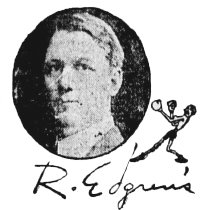
Robert Edgren
What this sketch of Robert Edgren's career fails to mention is that his father was J.A. Edgren, head of our Central Bible Seminary and that Robert spent childhood years here in Stromsburg. Thanks to editor Chattie Coleman and Wikipedia for filling in the facts.
-Dalakarl
...............................................................
Attic Treasures
First, there were some old Swedish church books. At the time of transition from the Swedish to the English language it was obvious that the younger generation was in danger of being left out of church life. They only knew English and church services were in Swedish. So a series called "Our Church" was published in English written just for this younger generation. What is amusing is that the English used was not the best. It was the best those old Swedes could do.
At the Monroe Evangelical Free church near Phillips, Nebraska, there is a cornerstone giving the original name of the church. It was known as the "Chicago Settlement," but the spelling on the stone was "Chicago Sättlämentet." That would be an example of a combination of Swedish and English...some called it "Swenglish." It was never easy to be bilingual.
But back at Jan's there emerged two more artifacts: anniversary plates picturing Immanuel church in Omaha and Edensburg church in Malmo, complete with brief histories printed on the back. Malmo, a few miles this side of Wahoo, is one of few places we know of named after an actual town in Sweden. Those plates have joined one from Council Bluff's only surviving Swedish church on our wall.
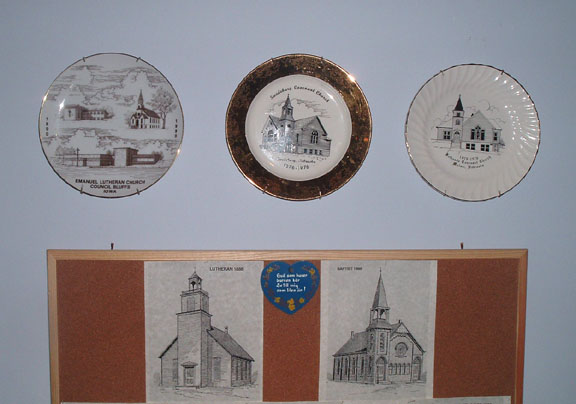
Two 1888 Stromsburg churches at bottom:
remember, that "Lutheran" church is now the Covenant church
Iliene Randell, Jan's mother-in-law, did something quite familiar to us...she went through old newspapers and wrote down any news relating to the Rystrom relatives which made for quite a collection. For some reason she also recorded many items about Dr. Flippin, which Kathy Nelson also finds very interesting.
But best of all, so far, is the scrapbook that Iliene kept of each step in the construction of their house on Seminary street. Though 1979 does not seem that long ago, pictures do not lie. The big trees were only tiny saplings. Seminary street was graveled. Jan and Terry's kids were all into putting handprints and footprints into the wet cement. Needless to say, they are still there.
-Dalakarl
......................................................................
More New Sweden, Iowa
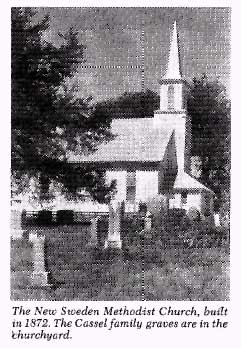 -
-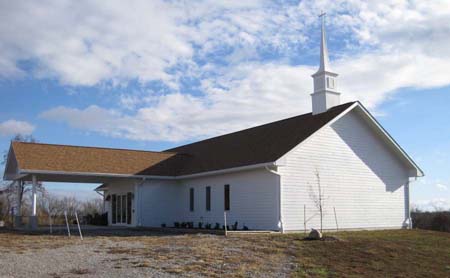
The old and new New Sweden Methodist churches
Polk County Historical Society President Charles Noyd recently returned from southeast Iowa where he spent a couple of days doing genealogical and historical research. He has since graciously shared a couple of books from the area including a partial manuscript called "Swedish Settlements in Iowa and Western Illinois," which had been found in a library. Here are some of the items of interest turned up in this book:
Near Stratford, Iowa, along the Des Moines River, there is a road that parallels its east bank where it makes a turn known as "Swede Bend." All that remains along that route is a marker showing where the first Swedish Mission congregation in America met until the church was moved to Twin Lakes Bible Camp near Manson. It is true that this building had been built by the Swedish Methodists, and the larger church they built to replace it is still in service a few miles to the east. This newly discovered book has the price for this sale...$150. Do we know that the Swedes were thrifty?
Another fact revealed in the book is that there was a log schoolhouse along this road that predated all of the Swedish churches. In those days their congregations met in the school; Lutherans, Baptists and Methodists! A similar situation was encountered at Swaburg, Nebraska, where the building still stands. There was a kind of unity borne of poverty and adversity.
It is unfortunate that this manuscript was never completed, so we have to rely on other sources for information on the New Sweden area where Noyd's interests lie, or for Council Bluffs where the information is sketchy. On the other hand, the material on Sioux City, Storm Lake, Burlington and other areas is excellent and more complete than any known source. The roster of Swedish newspapers published at Sioux City and elsewhere is very detailed and indicates the writer had intimate knowledge and interest in that subject, like an O.M. Nelson or his equivalent.
Only in such places can you read about a member of the Iowa Wahlstrom family who briefly joined merchant Ericson at the Swedeburg, Nebraska, store; or of Rev. Freden of the Saronville, Nebraska, Mission congregation, who according to C.F. Sandahl's account was nearly installed as pastor of Omaha's Immanuel Lutheran church. We often wondered what became of Freden...this book reveals he was one of those who went back to Sweden. In the 1930's it is surprizing to read that more Swedes were backtracking to Sweden than were coming over as immigrants! It was a little reported fact and a cloud on the horizon for those who hoped to perpetuate Swedish colonies in America.
-Dalakarl
.......................................................
A Ghost Railroad
There was a railway there, fully graded, but without tracks or ties! Grandma spoke with heartfelt disapproval of the cruelty with which the teamsters drove their horses in building that railroad grade. Through the years those embankments have yielded to time and deliberate leveling to return them to farmers' fields, fields which cover the burial places of many horses no doubt.
Two recent events have brought that scene to mind once again. Polk County Historical Society member and homestead researcher Rich Pearson placed in my hands a book entitled "A Real Live Railroad." Believe it or not, this is a book about that very railroad across from Grandma's. The story spans thirty years of ups and downs by a succession of dreamers and schemers who envisioned a railroad running south from Yankton, South Dakota, to Norfolk, a route which would go through my hometown of Wausa.
Yankton is on the Missouri River, and key to the railroad's feasibility would be the construction of a bridge crossing that river. That key failed to open the door in time. Dips in the economy and obstacles placed by competing railroads caused delay after delay in the road's progress. An interesting fact revealed by this book was that the financing of that and a number of other U.S. railroads came out of England. The potential returns for railroad development in America attracted investors from across the ocean.
Part of the challenge facing railroad development was wresting right-of-way land from owners. Railroad fever was not unlike interstate highway construction a century later. Many land owners then and now are enticed by the prospects of a lucrative interchange being built to their advantage or a local station for rail service. Towns which did not float bond issues for the planned railroad would be threatened by being bypassed.
In its final phase, the line was projected to reach all the way to Kansas, which would have brought it right through Polk county, and fulfilled the prophecy of early Stromsburg promotional material which showed railroads from all directions meeting here.
Remembering that promotional material at this month's genealogy meeting was the second link in the story. Ironically, the final approval of the Yankton bridge came at the same time the last hope of financial underpinnings evaporated from the railroad. So the bridge ended up carrying autos on both levels though the lower level was designed for train traffic...that never materialized.
-Dalakarl
..................................................................
York Cousins - part two

John and Elisabeth Nelson
There were fine portraits of John and Elisabeth, so now we know for the first time just what they looked like. There were also additional pictures of the Iowa Street home where they lived, and of the Schukneckt farm near Gresham which was home to Jane. One more recent picture was of Jane's mother Eleanora and her cousin Aina from Wausa (my great-aunt). They had this taken to show a striking family resemblance. John Nelson was a tall and stately man, and some of the Wausa kin have this same build, even to the present generation.
A very fascinating picture showed "Grandpa Nelson with his 1939 Cord Automobile." The Cord was a classic car; among the first front-wheel drive cars and so was ahead of its time. It was linked with the Auburn and Duesenberg cars. No doubt Grandpa Nelson was proud to own one.

Another picture which has continuing interest is one of a group of ladies from the Wayland Church southeast of town. Among them was Jane's mother, but she also pointed out Nina Cockle, who we knew from Covenant Home days, neighbor Joliene Lott Anderson's mother and Minnie Anderson's mother.

Young Jane at the Nels Johnson farm at Wausa
John's sister Elise was my great-grandmother. One picture has her sitting on the porch up at Wausa, just as I remember her, with a young Jane on the steps with her mother's cousin Elton Greenwall. The lady bending over is probably Elis's daughter Aina. Elton and his sisters were first cousins to both my mother and my father...but that's another story.
-Dalakarl
..........................................................
Golden Circle
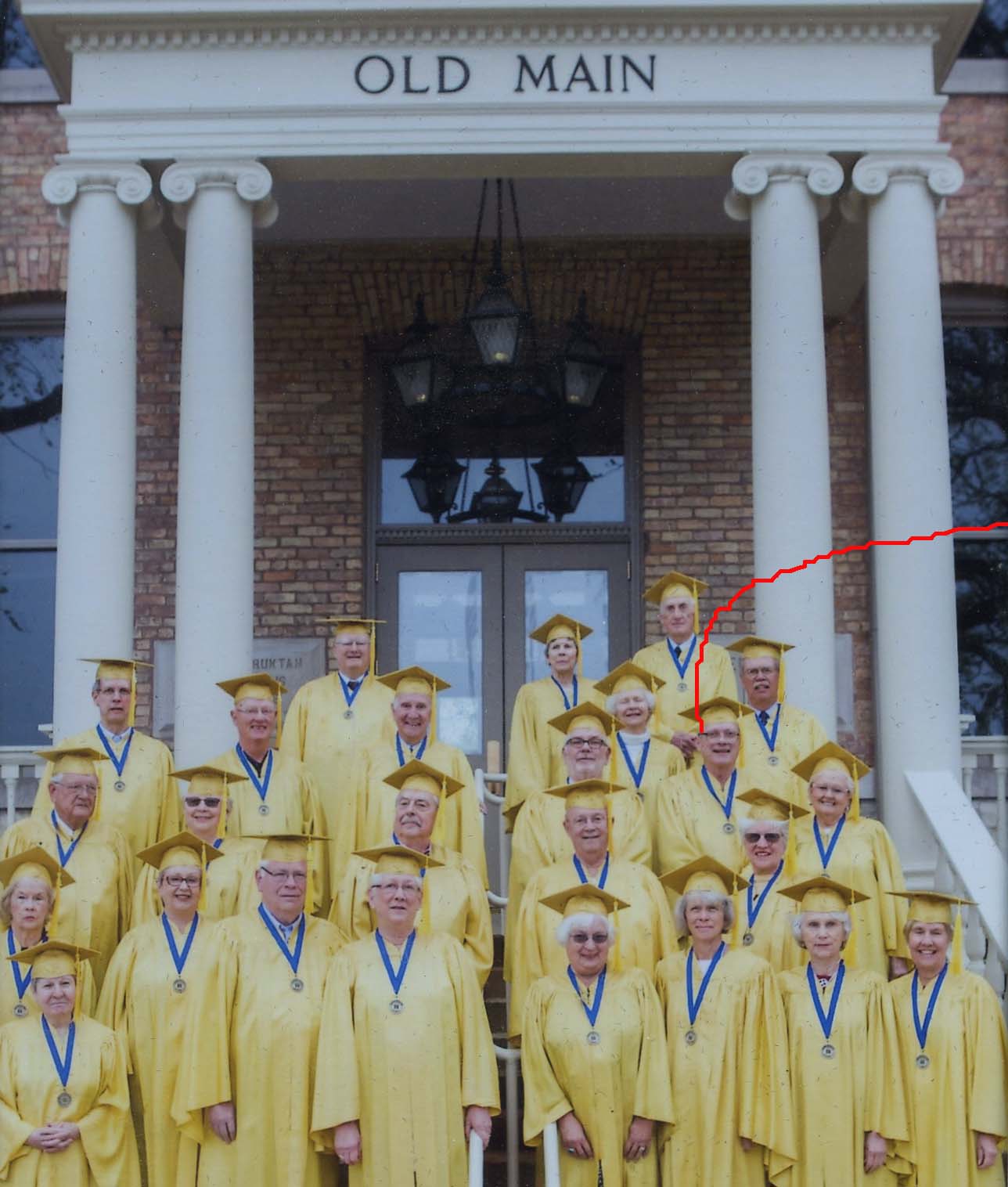
Some really good friends were among them, and now that our faces are appearing on social media we can all relive those happy moments. The alumni association provides us with gold colored robes and mortarboard hats, complete with tassels and we got to march in with the 2015 graduates (o.k., some would say "hobble in"). We were honored by an address from the current president of the school at a luncheon later in the day. Some of us hardened cynics fully expected pledge cards at our place settings, but we were pleasantly surprised to find no such thing.
A highlight was the tour of the newest building on campus, a science and student life center named after Nancy and Dr. G. Timothy Johnson. Those of our age remember Timothy as a seminary student at the time we were in school, and later he was the medical correspondent for ABC-TV. The tour was conducted in part by Pete Pearson, retired professor who also taught Mitch at North Park and along with Lee Horton was one of two in our class who served on the faculty.
One flaw in any alumni program is that it is limited to graduates. How about those who spent four, two, or even one year on campus but did not go on to graduate? I enjoyed visiting with a classmate or two who fit that category, and wish there were some way to extend recognition to them as well. By now we have all packed the annuals away again, but with one more "golden" memory of college days.
-Dalakarl
......................................................................
Finding Miss Julia part 1
The reason the one titled "Julia Johnson" sparked my interest is that some time ago it was learned that the daughter of Capt. Eric Johnson, Stromsburg editor, and so grand-daughter of "the prophet" Eric Jansson who founded Bishop Hill commune, had lived in Stromsburg. Could this picture be that very person?
A search of census and cemetery records turned up no Julias. Querying folks at the Senior Center, one of them past 100, also yielded no results. My Christmas gift membership in that popular genealogy program had not yet run out, so we began to look there. There was one Julia Johnson in the long list of returns, but she was born in Kansas and so seemed unlikely. A brother, Ernest G., was said to live in Osceola, and there is a man of that name buried there, but still no Julia.
Finally we looked for that famous ancestor, the prophet, and found a family tree including him. It was there that Julia C. Johnson's name finally appeared; living in Omaha with a Richards family and working for an insurance company as a stenographer (1930 census), and yes, she was born in Kansas. Her father was Capt. Eric Johnson, and her mother, Maria Octavia Troil.
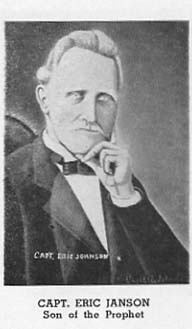
The earlier source about Eric had him leaving Stromsburg to edit papers in Holdrege, Nebraska, an later living in California. Why then did two of his children, Ernest and Julia, remain in Stromsburg? The Troil name may be the key. Maria died, according to family tree records, in 1890. But she would not have been the only Troil in Stromsburg. Rev. A.N. Sweders, one of my favorite early Mission preachers, was married to a Troil. His mother-in-law, Carolina Troil, owned land adjacent to his north of town.
She is buried in the Stromsburg cemetery next to the Sweders' family plot. But I have always wondered about a second name on her monument. It reads "Mary Troil 1847-1893 Blessed are the dead who die in the Lord." There is a two year discrepancy in the date of death, but genealogists are familiar with such discrepancies. It seems more than likely that the reason Julia and Ernest remained in Stromsburg was that they were in the care of their grandmother Troil or Aunt Sweders.
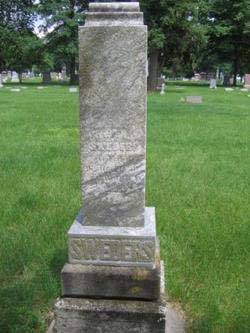
The Sweders monument at Stromsburg
Another problem is the fact that their mother is always referred to as "Mary Troil" and not "Mary Johnson." That would be unusual, but also unusual is the fact that her father-in-law, the prophet, arranged and approved all marriages in the Bishop Hill commune. Perhaps other formalities such as county records were ignored by his offspring. The Richards connection mentioned above could lead to interesting developments. Stay tuned for part two of "Finding Julia," featuring a visit to the Prairie Museum in Holdrege.
-Dalakarl
....................................................
Finding Miss Julia part 2
When the family tree mentioned last time came to light, there was no Hulda or Fredolph to be found. So that could not be our Julia. A search of our hard drive did turn up one more Julia Johnson reference, and that was in the Nebraska Swedish Methodist Conference history. It seems that a Julia Johnson played piano for the congregation at Swede Plain Methodist church. Sure enough, the Prairie Home precinct census for 1930 listed a Julia Johnson, daughter of Charles and Ida Johnson. Unfortunately, her siblings were Leonard, Philip, Nina and Oliver. No Hulda or Fredolph. Wrong Julia again. We still do not know who the Julia in that picture might be.

Prairie Museum: a "must see," contains artifacts from Phelps Center Orphanage, the rural Stockholm church,
and an ox yoke which brought Swedish back-trailers from Mormon Utah to Phelps county.
But a recent visit to the Prairie Museum in Holdrege on Genealogy Day was very productive. Not only did they recognize the name of Capt. Eric Johnson, but knew the story of his Bishop Hill roots and came up with some original source material that was amazing. In minutes, one of the researchers returned with "Swedes of Illinois," a book with a half-dozen references to Capt. Eric Johnson. Here are some of the findings:
After the "prophet's" death and the disbursement of the commune, son Eric was left with eleven acres to till. Soon the Civil War broke out, and he joined forces...at Camp Bureau near Princeton (where we lived for a year). Following the battle of Shiloh, he was promoted to Captain of the 57th Illinois, a regiment composed exclusively of Swedes. His two year stay as editor in Stromsburg was typical of his life: he owned or edited papers in Galva, Illinois, Holdrege, Wahoo and Fremont. He had been in government in Illinois and Nebraska.
He came to Stromsburg after a brief stint in the War Department in Washington D.C. His son Ernest, listed as a "printer" in one census, is recorded as publishing the Lindsay, Nebraska, paper, "The Lindsay Opinion." A later census has him managing the bowling alley in Osceola. All this from the Holdrege sources, but still very little about daughter Julia. When that happens, look forward to "Finding Julia - part three."
-Dalakarl
............................................................